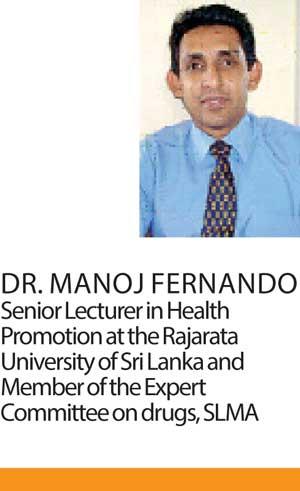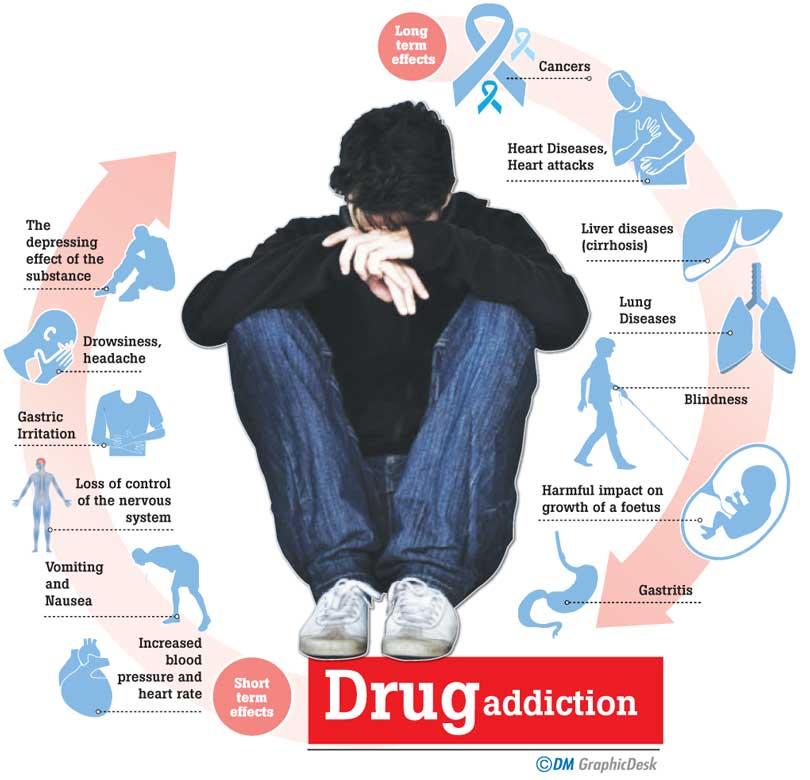12 Apr 2019 - {{hitsCtrl.values.hits}}

 Most often the society fails to see why addiction, particularly to substances, is difficult to overcome. Moreover, drug users are labelled as lacking in moral principles and willpower. Such stereotypes, instead of discouraging the habit, only discourage victims from seeking help.
Most often the society fails to see why addiction, particularly to substances, is difficult to overcome. Moreover, drug users are labelled as lacking in moral principles and willpower. Such stereotypes, instead of discouraging the habit, only discourage victims from seeking help.
Within Sri Lanka, the ‘trend’ that is drugs has seeped into victimize almost all parts of society.
According to the National Dangerous Drugs Control Board, even children below the age of 14 have experienced their first introduction to a substance.
On account of this reality, creating crucial awareness and sharing the facts of the issue, Dr. Manoj Fernando, Senior Lecturer in Health Promotion at the Rajarata University of Sri Lanka and Member of the Expert Committee on drugs, SLMA spoke to the Health Capsule.
Understanding the addiction
 “If an individual is to experience withdrawal symptoms due to the sustained use of a substance over a period of time, then it is safe to say that that person has fallen into addiction,” Dr. Fernando explained.
“If an individual is to experience withdrawal symptoms due to the sustained use of a substance over a period of time, then it is safe to say that that person has fallen into addiction,” Dr. Fernando explained.
The issue of addiction encapsulates multiple phenomena and conditions, each of which he addressed.
Physical dependence
“Physical dependence is also known as chemical dependence. It is a dependency that is created because of the chemical constituents of a particular drug. It usually takes time to develop, because the chemicals take time to generate the dependency within the individual,” Dr. Fernando expressed.
This physical dependence on substances is based on numerous factors which vary from person to person. These include: The duration of drug use, The Quantity, The Frequency and Biological qualities of the user.
Furthermore, “physical dependence also varies according to the type of the drug. The dependence is created sometimes by the drug itself, and on other times by the chemical ingredients of the drug. In Heroin, for example, the dependence producing substance is Diacetylmorphine (its active ingredient) which is mixed with various other compounds in a packet of heroin whereas in Alcohol, the Alcohol itself is addictive,” he continued.
Additionally, in Cannabis it is THC (Tetrahydrocannabinol) which is the main chemical compound that causes physical dependency and in cigarettes where 4000 harmful chemicals constitute the tobacco smoke, it is the addictive ingredient named Nicotine.
Psychological dependency
“Psychological dependency takes into account the psychological situation of a person. For example, certain myths, beliefs, opinions and perceptions created about a drug can lead to this. Most often, people are influenced by the attitudes and perceptions of the industry,” Dr. Fernando expressed.
He explained that once you take drugs, the need to continue is often aroused by this psychological dependency and this can develop even in occasional drug users.
According to him, the inability to unwind and have fun without the aid of drugs is a clear example of being psychologically dependent. Feeling empty and incomplete without drugs in such situations are symptoms of psychological ‘withdrawal.’
This condition is not synonymous with craving. An urge to use drugs may be natural especially in a person who has quit substance after a long period of use. Psychological dependence however, is beyond this. It is the conviction that drugs are absolutely necessary to achieve a sense of purpose, relief and relaxation whether it is at a social gathering, a party etc, that makes this differentiation. The main reason for this is the expectations of the person to use drugs which was created by drug related attitudes, beliefs, opinions and wrong perceptions.
Tolerance
“With time, the drug user increases the quantity of the drug to get the same effect due to the adaptation of the body to the dose the person was using for a long period. That is tolerance, “Dr. Fernando explained.
As the drug is used repeatedly, the body adapts to its continued presence, hence an individual who was once satisfied with a quarter of a bottle of alcohol, may with time need an entire bottle to experience that same effect. It is clear that while increasing the dosage may re-amplify its effects, it is also dangerously accelerating one’s tolerance.
Classifying drugs
Drugs may be classified in multiple ways; including illegal and legal. However this classification lacks any scientific basis.
“Some legal drugs are stronger than illegal ones. Tobacco for example kills 20,000 Sri Lankans and alcohol kills another 10,000 Sri Lankans annually,” Dr. Fernando said.
If we were to classify drugs based on their effect, we would find depressants, stimulants and hallucinogens to be the most relevant groups to Sri Lanka.
1. Depressants- These drugs would inhibit the function of one’s central nervous system. This is the most common type of substance in Sri Lanka.
Alcohol and Heroin are examples.
2. Stimulants – These stimulate the central nervous system, in an unsuspectingly harmful way. It will keep you awake and alert, but the danger occurs once the effect of the drug wears off. You may experience a downward trend where the brain cells are decreased by the release of neurotransmitters and the normal function of the brain is destroyed.
This will lead to various neurological and psychological complications.
Methamphetamines and amphetamines are examples.
3. Hallucinogens – These act on the central nervous system differently. Unpleasant auditory and visual hallucinations will cause its users to fall into addiction.
LSD and Cannabis are examples.
The Consequences
A few moments of exhilaration, escape and wrongly perceived ‘thrill’ may induce a greater cost than you imagined. Both in the short and long-terms, the body is made susceptible to a plethora of ill effects.
Short Term Effects are; the depressing effect of the substance, drowsiness, headache, imbalance, loss of control of the nervous system, gastric Irritation, vomiting and nausea and increased blood pressure and heart rate.
Long Term Effects are; cancers ( predominantly due to tobacco and alcohol), heart diseases, heart attacks, kidney failures, liver diseases like cirrhosis, lung diseases, sexual impotence in men, psychiatric diseases, blindness, gastritis, muscular disorders, harmful impact on growth of a foetus when pregnant mothers are exposed to substances
The link between alcohol dependency and suicide.
Withdrawal state
“One of the most important aspects of physical dependency is that when you try to stop taking a particular drug, there are certain physiological bodily responses called withdrawal symptoms. The duration and the intensity of the ‘withdrawal period’ varies based on the nature of the drug as well as the user,” Dr. Fernando stated.
Medication is particularly used in the management of withdrawal symptoms like tremors, body aches, diarrhoea and so on.
“Heroin withdrawal symptoms are mostly managed with psychotherapy techniques, but for alcohol dependency, medication is most likely needed,” he added.
And if a person is psychologically strong, motivated and more prepared for the recovery process, the withdrawal duration may be shorter.
For most drugs, the withdrawal period varies from 2 weeks to one month.
Treatment
The notion that once you have fallen victim to drugs, it is pointless to minimise or quit, is false. No matter when or how you push yourself to release your mind and body from the grip of addiction, you will make a difference. This is why it is important that treatment is sought out.
“Most of the time, the substance users do not need medical products to recover, because most often using a substance is a habitual or behavioural problem, so they require behavioural adjustments, the guidance of a capable therapist etc,” Dr. Fernando said.
However in the case of psycho-therapeutic approaches being unsuitable for an individual, specific medications may be the option.
Further urging treatment, Dr. Fernando expressed that “if an individual has recovered and stopped the particular drug, the risk to that individual reduces. Irrespective of the age or the duration of usage, it is always beneficial to minimise the risk and cut down on your intake.”
Proving his statement, the WHO reveals that a person who quits smoking would experience a list of health benefits:
nWithin a mere 20 minutes: their heart rate and blood pressure drops.
nWithin 2-12 weeks: Their circulation improves and their lung function increases.
nWithin 1 year: Their risk of coronary heart disease is about half of that of a smoker’s.
Additionally, a quitter
The way forward
The ideal scenario of course would be that drug consumers immediately terminate their relationship with these killer substances. However, even in the midst of hesitation or reluctance to do so, Dr. Fernando urges the consultation of a therapist or a doctor. For, being aware of the regularity and intensity of one’s habit is the first step toward controlling and minimizing it.
“Quitting is not that difficult. The industry and the people around make it seem difficult with their perceptions and opinions, “Dr. Fernando quipped.
As a society, instead of turning a blind eye to the issue or dropping labels, we too can aid their journey towards recovery. Families should support the victim and seek professional help together.And when it comes to the parents, their child’s entire world is in their hands.
According to the Global Youth Tobacco Survey (2015) 4 in 5 students saw anyone using tobacco on television, videos or movies. And 9 in 10 students noticed anti-tobacco messages in the media.This reveals to us that almost the entire young population of the country may be reached via media platforms.The decision to use this wide-scale tool to promote or discourage substance use however is in the hands of society as a whole.

20 Nov 2024 17 minute ago
20 Nov 2024 22 minute ago
20 Nov 2024 1 hours ago
20 Nov 2024 5 hours ago
19 Nov 2024 9 hours ago